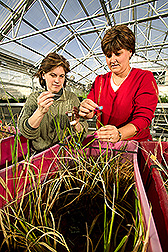This page has been archived and is being provided for reference purposes only. The page is no longer being updated, and therefore, links on the page may be invalid.
Read the magazine story to find out more. |
|
Preserving Wild Rice and Other Crops
By Marty ClarkApril 20, 2005
Nearly half a million samples of plant and animal germplasm are tucked away at the Agricultural Research Service's National Center for Genetic Resources Preservation in Fort Collins, Colo. But some species do not store well using conventional storage methods.
That's where plant physiologist Christina Walters' team in the Plant Germplasm Preservation Research Unit plays an important role. Team members find new methods to preserve samples that don't store well.
For example, wild rice seeds don't survive long and don't preserve easily. Many breeders just stick their wild rice seeds in a refrigerator.
Walters found that the water content of seeds can be optimized to make them neither too wet nor too dry. Some drying slows down seed aging and germination but does not hurt the seed. Drying also means less chance that lethal freezing will occur, so the seeds can survive at lower temperatures for longer times. Walters' group has shown that wild-rice seeds can be stored for at least three years at -5 degrees Celsius.
Scientists in Walters' unit are trying to solve a diverse array of germplasm-storage problems. Some recent projects include looking at ways to correctly identify garlic varieties--which are impossible to distinguish by variety name, and difficult to identify by appearance--to prevent unnecessary duplication in storage; trying to assess the genetic diversity of the bristlecone pine, which could be one of Earth's oldest living inhabitants; and developing new methods for storing grape germplasm.
Read more about the research in the April 2005 issue of Agricultural Research magazine.
ARS is the U.S. Department of Agriculture's chief scientific research agency.



